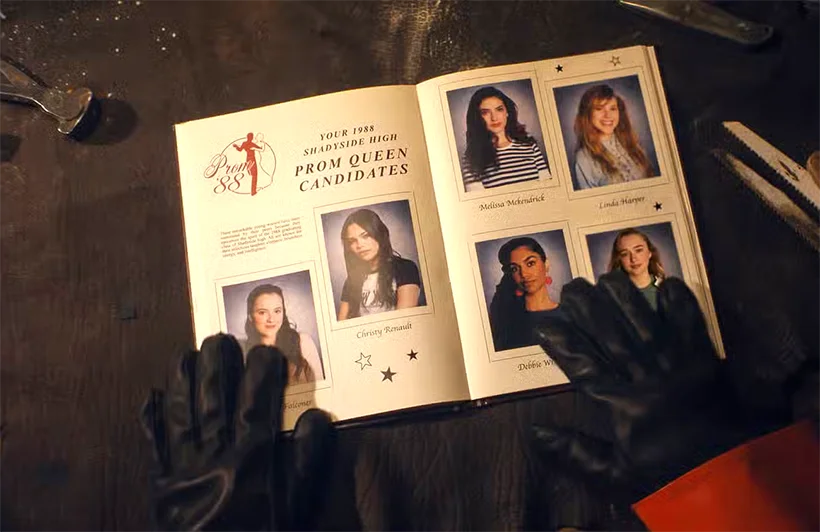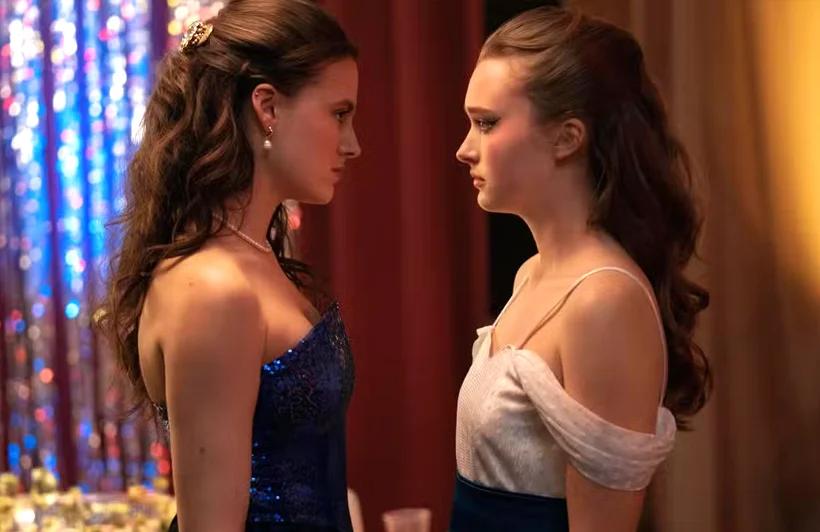Type and hit Enter to search
Experts in aesthetic surgery, dermatology, and beauty bring you the latest trends, research, and advice to help you make informed decisions about your appearance and health.
A web platform dedicated to aesthetic surgery, dermatology, and beauty, where expertise meets innovation, and your desires and needs become our mission. In a world where appearance and health go hand in hand, our platform leads the revolution, delivering the latest trends, research, and expert advice directly to you.
Our team consists of highly skilled professionals in the fields of aesthetic surgery and dermatology, committed to providing reliable information and guidance that will help you make informed choices about your appearance and well-being. We understand that every individual has unique needs and desires, which is why we approach each person with the utmost care and professionalism.
Powered by Aestetica Web Design © 2024
I decoded Fear Street: Prom Queen Post-Credits Scene—Turns out, it was just the beginning
I thought I was done with Fear Street: Prom Queen after credits rolled, but that blood-soaked symbol had other plans. While everyone else headed for the exits, I stayed glued to my screen—and witnessed the franchise's most jaw-dropping revelation unfold in those final 30 seconds. That pentagram wasn't just decoration; it was a declaration of war against everything we thought we knew about Shadyside's curse. The devil's mark, Nancy's sacrifice, the occult symbolism—it all clicked into place like pieces of a supernatural jigsaw puzzle designed to haunt your dreams.
I Stayed Through Fear Street: Prom Queen Post-Credits Scene and Found Evidence of Horror’s Perfect Crime
When the Credits Roll But the Horror Doesn’t Stop—Fear Street: Prom Queen Post-Credits Scene Explained
Most people bolt for the bathroom the second credits start rolling. Smart move for most films—terrible mistake for Fear Street: Prom Queen. The post-credits scene doesn’t just add a cherry on top; it detonates everything you thought you understood about the preceding 90 minutes.
The Fear Street Prom Queen after credits sequence operates on a simple principle: when your guard is down, that’s when real horror strikes. Director Matt Palmer knows exactly what he’s doing here. You’ve survived the slasher mayhem, processed the emotional beats, maybe even started mentally drafting your review—and then the film grabs you by the throat one last time.
What happens in the Fear Street Prom Queen after credits scene explained comes down to pure visual storytelling. No dialogue, no exposition dumps, just a series of carefully orchestrated images that recontextualize everything. The camera lingers on details that seemed insignificant during the main narrative, transforming throwaway moments into crucial plot points.
Visual Storytelling at Its Most Ruthless
The Fear Street Prom Queen closing scene employs a technique horror veterans will recognize: the slow reveal. Each frame builds tension through what it doesn’t show as much as what it does. The lighting shifts from the warm, nostalgic glow of 1988 prom night to something colder, more clinical. This isn’t accidental—it’s the visual equivalent of pulling back a curtain to reveal the machinery behind the magic trick.
The Fear Street Prom Queen final moments work because they respect the audience’s intelligence. There’s no hand-holding, no convenient character explaining what just happened. Instead, Palmer trusts viewers to piece together the implications of what they’re seeing. It’s a gamble that pays off spectacularly for anyone willing to engage with the material on its own terms.
Nancy’s Final Sacrifice: The Blood Symbol That Changes Everything
Nancy Falconer’s death hits differently when you know what comes after. During the main film, her demise feels tragic but straightforward—another casualty in Shadyside’s long history of supernatural violence. The Fear Street Prom Queen Nancy blood scene takes on entirely new dimensions once you’ve seen how her story truly ends.
The Pentagram That Rewrites History
The Fear Street Prom Queen blood symbol isn’t just decoration. It’s a signature, a calling card, a promise of things to come. When Nancy’s blood forms that perfect pentagram in the post-credits sequence, it’s not random supernatural nonsense—it’s the universe itself making a statement about power, sacrifice, and the price of knowledge.
The Fear Street Prom Queen Nancy Falconer death scene meaning explained requires understanding her character arc in reverse. She wasn’t just an unlucky teenager caught in supernatural crossfire. The blood pentagram suggests she was always meant to be the catalyst, the final ingredient in something much larger than a simple revenge plot.
Practical Effects Meet Metaphysical Implications
The practical effects team deserves serious credit for making the Fear Street Prom Queen blood pentagram feel both visceral and otherworldly. Real blood (or convincing fake blood) behaves in specific ways—it pools, it coagulates, it doesn’t naturally form geometric patterns. Making that pentagram look both supernatural and believable required serious technical skill.
But the visual impact goes beyond mere craftsmanship. The Fear Street Prom Queen Nancy Falconer death transforms from tragedy to ritual when viewed through the lens of that blood symbol. Nancy wasn’t murdered—she was sacrificed. And sacrifices, unlike murders, serve a purpose.

The Devil’s Mark Revealed: Occult Symbolism and Hidden Messages
The Fear Street Prom Queen devil’s mark doesn’t announce itself with fanfare. It emerges gradually, almost organically, from the visual chaos of the post-credits sequence. This subtlety makes it more unsettling than any jump scare could manage.
The Fear Street Prom Queen witch’s mark draws from centuries of occult tradition. These symbols weren’t invented for the film—they’re rooted in actual historical practices, from medieval grimoires to colonial-era witch trials. Palmer and his team clearly did their homework, because the symbols feel authentic rather than Hollywood-generic.
The Fear Street Prom Queen pentagram meaning extends beyond simple devil worship. In occult traditions, pentagrams represent the five elements, the human form, the connection between earthly and divine realms. When inverted or drawn in blood, the symbolism shifts toward summoning, binding, or marking territory. Context matters enormously in occult symbolism, and the context here is unmistakably sinister.
Visual Language of Power and Corruption
The Fear Street Prom Queen occult symbols function as a visual language that speaks to anyone familiar with horror iconography. But they’re not just there to look spooky—each symbol carries specific meaning within the film’s mythology. The devil’s mark identifies ownership, the witch’s mark indicates allegiance, and the blood pentagram serves as both seal and signature.
The Fear Street Prom Queen witch mark symbol meaning and significance becomes clear when you consider the broader Fear Street universe. These aren’t random supernatural elements—they’re part of a coherent system of magical thinking that connects Prom Queen to the larger franchise mythology. The symbols suggest that what happened in 1988 wasn’t an isolated incident but part of a pattern stretching back centuries.
The genius of Palmer’s approach lies in trusting the audience to make these connections without spelling them out. The symbols are there for anyone who wants to dig deeper, but they don’t derail the narrative for viewers who just want a good scare. It’s sophisticated horror filmmaking that respects both casual viewers and franchise devotees.
Connecting the Dots: How Prom Queen’s Ending Ties Into the Fear Street Universe
Sarah Fier’s Shadow: Tracing the Curse Through Time
The Fear Street Prom Queen Sarah Fier connection isn’t immediately obvious—and that’s exactly the point. Unlike the original trilogy, which wore its supernatural heritage on its sleeve, Prom Queen operates more like a sleeper cell, quietly establishing its place in the cursed timeline before revealing its true allegiance in those final moments.
How does Fear Street Prom Queen connect to Sarah Fier curse timeline? The answer lies in understanding that curses, like viruses, mutate over time. The supernatural forces that plagued Shadyside in 1666, 1978, and 1994 didn’t simply vanish—they adapted, finding new hosts and new methods of manifestation.
The Fear Street Prom Queen 1666 connection becomes clearer when you examine the patterns. Sarah Fier’s original curse operated through possession, turning ordinary townspeople into killers. By 1988, the supernatural influence had grown more sophisticated, working through symbols, rituals, and willing participants rather than brute-force possession.
The Fear Street Prom Queen curse explanation reveals a maturation of malevolent forces. Where earlier manifestations relied on chaos and random violence, the 1988 events suggest a more calculated approach. The curse had learned patience, subtlety, and the art of long-term planning.
Thematic Consistency Across Time Periods
The Fear Street Prom Queen franchise connection operates on thematic rather than narrative levels. Each time period showcases how supernatural evil adapts to contemporary fears and social structures. The 1666 witch trials, the 1978 summer camp slasher, the 1994 mall massacre, and the 1988 prom night horror all reflect their respective eras while maintaining core supernatural DNA.
What makes Prom Queen particularly clever is how it uses 1988’s specific cultural anxieties—the Satanic Panic, heavy metal hysteria, and teenage rebellion fears—as vehicles for ancient evil. The curse doesn’t just repeat itself; it evolves, finding new ways to exploit human weakness and social division.
The Goode Family Legacy: Unraveling Generations of Dark Secrets
The Fear Street Prom Queen Goode family connection operates more through absence than presence. Unlike the original trilogy, where the Goode family’s supernatural dealings took center stage, Prom Queen suggests alternative power structures at work in Shadyside’s cursed ecosystem.
The Fear Street Prom Queen Shadyside connection raises intriguing questions about the town’s supernatural geography. If the Goode family controlled supernatural forces through the 1990s, what was happening in 1988? The film hints at competing factions, rival supernatural interests, or perhaps a power vacuum that other forces rushed to fill.
The Fear Street Prom Queen Goode family connection to original trilogy explained becomes a study in supernatural politics. The 1988 events might represent a challenge to Goode authority, a parallel power structure, or even a supernatural rebellion against established occult hierarchies. The blood symbols and ritual elements suggest organized supernatural activity independent of Goode influence.
Expanding the Supernatural Ecosystem
The Fear Street Prom Queen trilogy connection works by expanding rather than contradicting established lore. Instead of another Goode family manipulation, we see evidence of Shadyside’s supernatural complexity. The town wasn’t just cursed by one family’s deal with dark forces—it became a supernatural nexus attracting multiple forms of evil.
This approach enriches the Fear Street Prom Queen franchise future by suggesting that Shadyside’s problems run deeper than any single family’s corruption. Even with the Goode curse broken, the town remains vulnerable to supernatural influence from other sources, other traditions, other forms of ancient evil seeking modern expression.
Easter Eggs and Hidden References: The Devil’s in the Details
The Fear Street Prom Queen Easter eggs operate on multiple levels, rewarding both casual viewers and franchise obsessives. Unlike heavy-handed references that break immersion, these details feel organic to the 1988 setting while establishing crucial connections to the broader Fear Street universe.
The Fear Street Prom Queen hidden meanings emerge through careful observation rather than obvious exposition. Street names, background signage, character surnames, and even clothing choices contain references to previous films and R.L. Stine’s original works. These details create a sense of lived-in continuity that makes Shadyside feel like a real place with genuine history.
The Fear Street Prom Queen 1990 movie reference works particularly well because it doesn’t feel forced. The characters naturally discuss contemporary horror films, and their choices reveal both period-appropriate tastes and subtle nods to the franchise’s own aesthetic influences. It’s world-building that doubles as cultural commentary.
Bridging Source Material and Screen Adaptation
The Fear Street Prom Queen R.L. Stine adaptation demonstrates how to honor source material while creating something genuinely cinematic. The Easter eggs don’t just reference Stine’s books—they translate his storytelling sensibilities into visual language. Character archetypes, plot structures, and thematic concerns from the original works appear in transformed but recognizable forms.
The Fear Street Prom Queen Easter eggs and hidden references to original trilogy create a sense of supernatural continuity that extends beyond simple fan service. These details suggest that Shadyside’s residents have always lived with supernatural undercurrents, even when they don’t fully understand what they’re experiencing.

Behind the Screams: Director Matt Palmer’s Vision and Creative Choices
From Page to Screen: Adapting R.L. Stine’s Vision for Modern Audiences
The Fear Street Prom Queen Matt Palmer director brings a distinctly cinematic sensibility to material that could easily have felt like extended television. Palmer understands that adapting beloved source material requires more than faithful translation—it demands creative interpretation that honors the original while creating something genuinely new.
Matt Palmer Fear Street Prom Queen interview reveals a director who takes adaptation seriously without taking himself too seriously. Palmer’s approach focuses on capturing the emotional truth of Stine’s work rather than slavishly reproducing plot details. The result feels both familiar and surprising, like revisiting a childhood memory that’s somehow more vivid than you remembered.
The Fear Street Prom Queen director explains ending in terms that emphasize visual storytelling over exposition. Palmer trusts his audience to understand complex supernatural concepts through imagery and implication rather than dialogue-heavy explanations. This approach elevates the material beyond typical young adult horror into something more sophisticated and lasting.
Creative Decisions That Define the Experience
The Fear Street Prom Queen book vs movie ending showcases Palmer’s willingness to expand beyond source material when necessary. While Stine’s original work provides the foundation, Palmer’s ending adds layers of meaning and franchise connectivity that enhance rather than contradict the source material’s intentions.
Matt Palmer Fear Street Prom Queen director interview about ending explained reveals a filmmaker who understands that successful adaptation requires creative courage. Palmer doesn’t simply translate text to screen—he translates the experience of reading Stine’s work into the experience of watching a Fear Street film.
The Art of the Post-Credits Scene: Why Timing Is Everything
The Fear Street Prom Queen mid credits scene represents a masterclass in audience manipulation—the good kind. Palmer understands that horror works best when it subverts expectations, and placing crucial story information after the credits creates a unique viewing experience that rewards patience and attention.
Why Fear Street Prom Queen has important scene post credits explained comes down to understanding audience psychology. Most viewers experience emotional release when credits roll—they’ve survived the horror, processed the story, and begun mentally transitioning back to reality. The post-credits scene yanks them back into the narrative just when they thought they were safe.
The Fear Street Prom Queen end credits explained demonstrates how timing affects impact. The same revelation placed during the main narrative would feel like just another plot twist. Positioned after the credits, it becomes something more significant—a promise, a threat, a glimpse behind the curtain that recontextualizes everything that came before.
The Fear Street Prom Queen credits scene explained reveals Palmer’s understanding of modern viewing habits. In an era of franchise filmmaking and shared universes, post-credits scenes have become expected elements. Palmer uses this expectation to his advantage, delivering genuine story content rather than simple sequel teasing.
The Fear Street Prom Queen alternate ending possibilities were clearly considered during production, but Palmer’s final choice demonstrates confidence in his vision. Rather than hedging bets with multiple possible conclusions, he commits fully to a specific interpretation that serves both the individual film and the broader franchise.
Cut Content and Alternate Endings: What Almost Was
The Fear Street Prom Queen cut scenes reveal a production process that prioritized narrative efficiency over comprehensive world-building. Palmer and his team clearly shot more material than made it into the final cut, but their editing choices demonstrate disciplined storytelling that serves the overall experience.
The Fear Street Prom Queen deleted scenes and alternate endings explained show how films evolve during post-production. Early cuts apparently included more explicit connections to the original trilogy, but Palmer ultimately chose subtlety over obviousness. The deleted material might satisfy franchise completists, but its absence makes the final film more accessible to newcomers.
The Fear Street Prom Queen alternate ending variations suggest that Palmer experimented with different levels of supernatural revelation. Some versions apparently made the occult connections more explicit, while others left more ambiguity. The final choice strikes an effective balance between clarity and mystery.
Impact on Franchise Continuity
The Fear Street Prom Queen spoilers ending in its final form creates maximum flexibility for future installments. By leaving certain questions unanswered and certain connections implicit, Palmer gives future filmmakers room to expand the mythology without contradicting established canon.
The Fear Street Prom Queen deleted post credits content hints at even more extensive supernatural world-building that didn’t make the final cut. While this material might surface in director’s cuts or special features, its absence from the theatrical version demonstrates Palmer’s commitment to tight, focused storytelling over encyclopedic completeness.
What Comes Next: Sequel Hints and Franchise Future
Reading the Tea Leaves: How the Post-Credits Scene Sets Up Future Installments
The Fear Street Prom Queen sequel setup operates with the subtlety of a supernatural chess master making moves three games ahead. Unlike typical horror franchises that telegraph their sequel intentions with the grace of a sledgehammer, Prom Queen’s after-credits sequence plants seeds that could bloom in multiple directions depending on audience response and Netflix’s algorithmic whims.
The Fear Street Prom Queen sequel hints embedded in those final moments create what screenwriters call “franchise insurance”—story elements that can be developed or abandoned based on commercial success. The blood pentagram doesn’t just close Nancy’s story; it opens a doorway to supernatural possibilities that future filmmakers can walk through or ignore entirely.
The Fear Street Prom Queen after credits scene sequel setup explained reveals a carefully constructed narrative trap. Every symbol, every lingering shot, every unanswered question serves dual purposes: satisfying the current story while creating hooks for potential sequels. It’s the kind of strategic storytelling that keeps studio executives happy and creative teams flexible.
The Fear Street Prom Queen series continuation possibilities multiply when you consider the franchise’s anthology structure. The after-credits scene doesn’t lock future installments into specific storylines—it creates a supernatural framework that can accommodate different time periods, characters, and creative approaches while maintaining thematic consistency.
Questions That Demand Answers
The most effective Fear Street Prom Queen franchise future scenarios emerge from questions the film deliberately leaves unanswered. Who else knows about the occult symbols? How long have these supernatural forces been active in Shadyside? What other families besides the Goodes have supernatural connections? The after-credits scene raises these questions without providing easy answers, creating narrative space for future exploration.
The genius of this approach lies in its flexibility. Future filmmakers can choose which threads to pull, which mysteries to solve, and which questions to leave dangling for even later installments. It’s franchise building that prioritizes creative possibilities over rigid continuity requirements.
The Netflix Factor: How Streaming Success Shapes Horror Franchises
The Fear Street Prom Queen Netflix 2025 release represents a fascinating case study in how streaming platforms approach franchise development. Unlike theatrical releases that live or die based on opening weekend box office numbers, Netflix content succeeds through sustained engagement metrics that can take weeks or months to fully materialize.
Streaming Metrics vs. Traditional Success Indicators
The Fear Street Prom Queen Netflix ending gains additional significance when viewed through the lens of streaming analytics. Netflix doesn’t just measure how many people watch—they track completion rates, rewatch behavior, social media engagement, and dozens of other data points that influence sequel decisions. The after-credits scene becomes a metric-generating device, encouraging viewers to watch until the very end and potentially rewatch to catch details they missed.
The Fear Street Prom Queen Netflix 2025 release sequel potential explained depends on understanding how streaming platforms evaluate horror content. Netflix has discovered that horror franchises generate particularly strong engagement metrics—viewers binge-watch entire series, rewatch favorite installments, and create extensive online discussions that drive additional viewership through word-of-mouth marketing.
Platform-Specific Storytelling Strategies
The Fear Street Prom Queen standalone connection to the broader franchise reflects Netflix’s preference for content that works both independently and as part of larger narratives. Viewers can enjoy Prom Queen without having seen the original trilogy, but franchise fans get additional layers of meaning and connection. It’s a storytelling approach designed specifically for streaming platforms where viewers might encounter content in any order.
The Fear Street Prom Queen lore explained through the after-credits scene serves Netflix’s algorithmic recommendation system. The platform’s AI can identify viewers who engage deeply with franchise content and recommend related titles, creating viewing patterns that keep subscribers engaged across multiple horror properties. The supernatural symbols and franchise connections become data points that help Netflix understand and predict viewer preferences.
Fan Theories and Community Speculation: What the Internet Thinks Happens Next
The Fear Street Prom Queen mythology has generated the kind of online speculation that studio executives dream about—passionate, detailed, and endlessly creative fan theories that keep the franchise alive in digital spaces between official releases. The after-credits scene provides just enough information to fuel speculation while leaving enough ambiguity to prevent any single theory from becoming definitive.
The Fear Street Prom Queen film analysis emerging from online communities demonstrates the sophisticated media literacy of modern horror fans. These aren’t casual viewers posting random thoughts—they’re conducting frame-by-frame analysis, cross-referencing symbols with historical occult practices, and building detailed timelines that connect Prom Queen to the broader Fear Street universe.
The Fear Street Prom Queen fan theories about after credits scene meaning range from plausible to wildly creative, but they all share a common thread: deep engagement with the material. Fans aren’t just consuming the content—they’re actively participating in its creation by developing interpretations and predictions that sometimes influence official franchise development.
Symbolism as Community Building Tool
The Fear Street Prom Queen horror symbolism has become a shared language for online fan communities. The blood pentagram, the occult markings, and the supernatural imagery provide common reference points that allow fans to communicate complex theories efficiently. These symbols function as both narrative elements and community building tools that create shared understanding among franchise enthusiasts.
The Fear Street Prom Queen occult meaning discussions reveal how modern audiences approach horror symbolism with genuine scholarly interest. Fans research historical occult practices, analyze mythological references, and debate symbolic interpretations with the kind of intellectual rigor typically reserved for academic literature courses. The after-credits scene becomes a text to be decoded rather than simply consumed.
The most compelling fan theories recognize that the Fear Street franchise operates on multiple levels simultaneously—as entertainment, as mythology, and as cultural commentary. The after-credits scene rewards this multilayered engagement by providing content that works whether you’re a casual viewer looking for scares or a dedicated fan seeking deeper meaning and franchise connections.
These online discussions create a feedback loop that influences franchise development. Studio executives and creative teams monitor fan theories, gauge community reactions, and sometimes incorporate popular fan interpretations into official canon. The after-credits scene becomes a conversation starter that extends the film’s cultural impact far beyond its runtime.
SOURCES:
4 Years Later, Netflix’s Most Promising Horror Movie Franchise Is Dangerously Close to Sending Fans Running, Fear Street: Prom Queen director on slashers & executing the perfect kill, Fear Street: Prom Queen Ending & Killer Identity Explained, Fear Street: Prom Queen Ending, Mid-Credits Scene & Sequel Explained, Fear Street: Prom Queen Director & Cast Preview Their Gory 1980s Party Movie, Who Lives, Who Dies, and Who Takes the Crown in Fear Street: Prom Queen?, Fear Street: Prom Queen Review – A Date to Forget.



